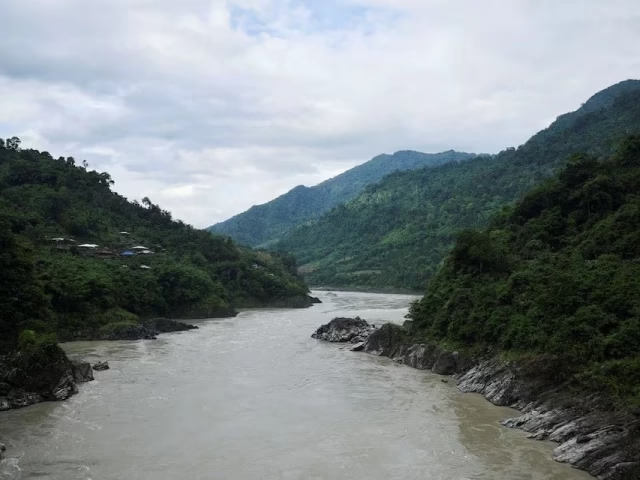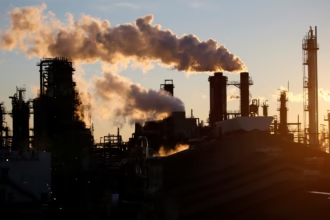India fears a planned Chinese mega-dam in Tibet will reduce water flows on a major river by up to 85% during the dry season, according to four sources familiar with the matter and a government analysis seen by Reuters, prompting Delhi to fast-track plans for its own dam to mitigate the effects.
The Indian government has been considering projects since the early 2000s to control the flow of water from Tibet’s Angsi Glacier, which sustains more than 100 million people downstream in China, India and Bangladesh. But the plans have been hindered by fierce and occasionally violent resistance from residents of the border state of Arunachal Pradesh, who fear their villages will be submerged and way of life destroyed by any dam.
Then in December, China announced that it would build the world’s largest hydropower dam in a border county just before the Yarlung Zangbo river crosses into India. That triggered fears in New Delhi that its longtime strategic rival – which has some territorial claims in Arunachal Pradesh – could weaponize its control of the river, which originates in the Angsi Glacier and is known as the Siang and Brahmaputra in India.
Read More: India alerts Pakistan about upcoming flood threats
India’s largest hydropower company in May moved survey materials under armed police protection near a prospective site of the Upper Siang Multipurpose Storage Dam, which would be the country’s biggest dam, if completed. Senior Indian officials have also been holding meetings about accelerating construction this year, including one organized in July by Prime Minister Narendra Modi’s office, according to two of the sources, who spoke on condition of anonymity to discuss sensitive government matters.
Delhi’s concerns were described in the undated Indian government analysis of the Chinese dam’s impact, the specifics of which Reuters corroborated with four sources and is reporting for the first time.
Beijing hasn’t released detailed plans about the dam’s construction, but the analysis drew on past work conducted by Indian government-affiliated institutions like the Central Water Commission and accounted for the expected size of the Chinese project, which broke ground in July and will cost nearly $170 billion.
Delhi estimates the Chinese dam will allow Beijing to divert as much as 40 billion cubic meters of water, or just over a third of what is received annually at a key border point, according to the sources and the document. The impact would be especially acute in the non-monsoon months, when temperatures rise and lands become barren across swathes of India.
The Upper Siang project would alleviate that with its projected 14 BCM of storage capacity, allowing India to release water during the dry season. That could mean the major regional city of Guwahati, which is dependent on water-intensive industry and farming, would see a reduction in supply of 11%, according to the sources and the document, as opposed to 25% if the Indian dam isn’t built.
The project could also mitigate any move by Beijing to release devastating torrents of water downstream, the sources said.
If the dam is at its minimum drawdown level – where water is stored at less than 50% of its height – it would be able to fully absorb any excess water released from a breach in Chinese infrastructure, according to the document and the sources. India is considering a proposal to keep 30% of its dam empty at any time in order to account for unexpected surges, two of the sources said.
A spokesperson for China’s foreign ministry said in response to Reuters’ questions that the hydropower projects “have undergone rigorous scientific research on safety and environmental protection, and will not adversely impact the water resources, ecology, or geology of downstream countries.”
“China has always maintained a responsible attitude toward the development and utilization of transboundary rivers, and has maintained long-term communication and cooperation with downstream countries such as India and Bangladesh,” the spokesperson added.
Also Read: China hails Pak army as ‘guardian of friendship’
Modi’s office and the Indian ministries responsible for water and external affairs did not respond to Reuters’ questions. State-owned hydropower major NHPC also did not return a request for comment.
India’s foreign ministry has said that top diplomat S. Jaishankar raised concerns about the dam during a meeting with his Chinese counterpart on Aug. 18. A Jaishankar deputy also told lawmakers in August that the government was implementing measures to safeguard the lives and livelihoods of citizens in downstream areas, including building the dam.
India has itself been accused by Pakistan, a Chinese ally that it briefly clashed with in May, of weaponizing water. Delhi this year suspended its participation in a 1960 water-sharing treaty with Islamabad and is considering diverting flows from another crucial river away from its downstream neighbour.
An international tribunal has ruled that India must adhere to the agreement but Delhi says the panel lacks jurisdiction.
Development or destruction?
When NHPC workers moved surveying materials near the village of Parong in May, angry locals damaged their machinery, destroyed a nearby bridge and looted the tents of police sent to guard the operation.
Many of them are members of Arunachal’s Adi community, who live off paddy, orange and sweet lime farms in the mist-shrouded hills and valleys nourished by the Siang.
The villagers have set up makeshift watch posts on regional roads to deny access to NHPC workers. That has forced security personnel to trek miles, often under cover of night, to reach a prospective site of the dam.
At least 16 Adi villages are likely to be lost to the storage area of the dam, directly affecting an estimated 10,000 people, according to two of the sources. Community leaders say more than 100,000 people will be impacted overall.
“The cardamom, paddy, jackfruit and pear we grow on this land help educate our children and support our family,” said Odoni Palo Pabin, an Adi grocer and mother of two. “We will fight the dam to death.”
The dam has the support of Arunachal’s chief minister, who is a member of Modi’s party and has called the Chinese project an existential threat.
The project will “ensure water security and provide flood moderation to counter any potential water surges,” the state government said in a statement, adding that it decided in June to engage in detailed compensation discussions with families that could be affected by the dam.
Lawmaker Alo Libang, an Adi who represents an area that would be submerged by the Indian project, said he believed locals could be convinced to move if they received generous compensation.
NHPC has plans to spend more than $3 million on education and emergency infrastructure to incentivize the villagers to move elsewhere, three of the sources said, citing instructions from Modi’s office.
In one sign of progress, three villages in the area recently agreed to let NHPC officials carry out dam-related work, according to the Arunachal government and dozens of locals.
India has a history of activist movements against large dams, which have sometimes slowed these projects by years or forced them to scale down.
Even if the Upper Siang dam gets the go-ahead, it could take a decade to build after breaking ground, according to four of the sources. That means the project would likely be completed after China’s project, which Beijing expects to start generating power by the early-to-mid 2030s.
The delay means an Indian project would be vulnerable during construction if Beijing suddenly releases water during the monsoon season, triggering a surge that could wash away temporary dams, two of the sources said.
International experts and Adi activists have also warned that building large dams in seismically active Tibet and Arunachal could heighten risks for downstream communities.
The Chinese “dam is being built in a zone of high seismicity and in a zone that experiences extreme weather events,” said Sayanangshu Modak, an expert on the India-China water relationship at the University of Arizona.
“These kinds of extreme weather events trigger landslides, mudslides, glacial lake outburst flooding,” he said. “So that raises concerns about dam safety… it’s a very legitimate concern and India should engage with China.”









